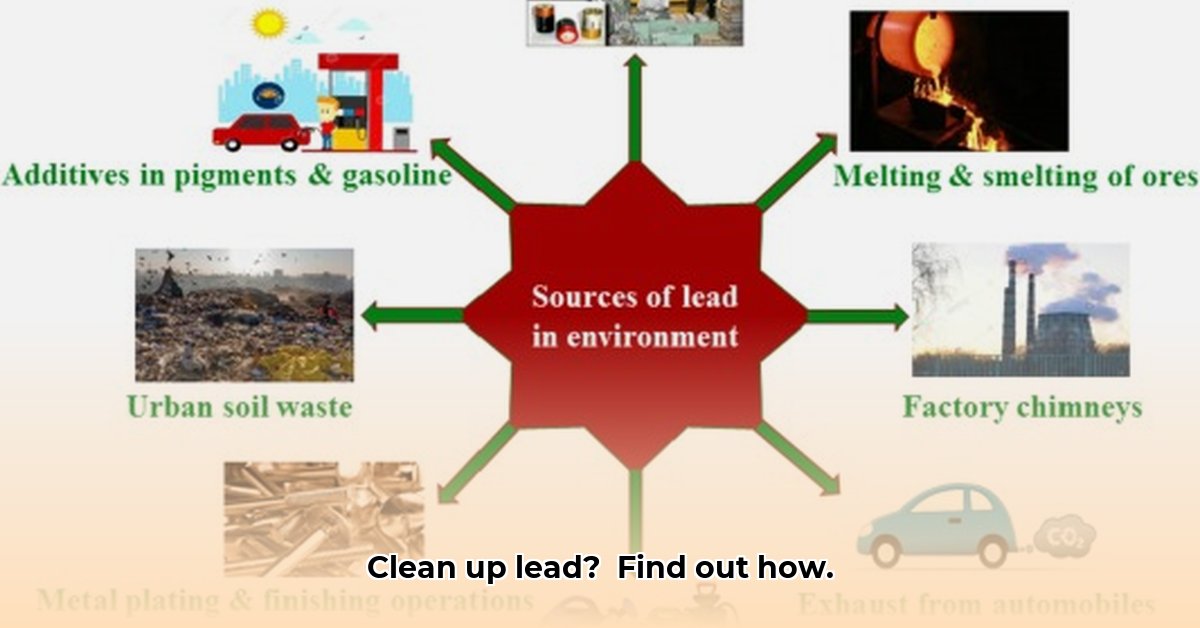
Lead contamination poses a significant threat to human health and the environment. Effective remediation strategies are crucial for mitigating this risk. This article explores various approaches to lead density environmental remediation, emphasizing the importance of a site-specific, scientifically-driven approach. Understanding lead's persistence and toxicity is paramount for successful remediation efforts. For more information on lead density, see this helpful resource.
Understanding the Scope of Lead Contamination
Lead pollution is a persistent problem stemming from historical industrial practices and some ongoing manufacturing processes. Lead's high toxicity, particularly for children, necessitates proactive remediation efforts. The long-term persistence of lead in soil and its potential for bioaccumulation underscore the urgency of addressing this issue. Even low concentrations can pose significant health risks. Furthermore, lead's mobility in the environment, influenced by factors such as soil pH and the presence of microbial communities, complicates remediation efforts, requiring a nuanced approach. How can we effectively and efficiently address this widespread and persistent pollutant?
Effective Remediation Strategies: A Multifaceted Approach
Several remediation techniques exist, each with its strengths and limitations. The optimal approach depends on factors like the extent of contamination, soil type, and regulatory requirements.
1. Excavation and Disposal
Traditional excavation and removal of contaminated soil remain an effective method, especially for sites with high lead concentrations. This approach ensures complete removal of the contaminant making it a highly reliable option. However, it's expensive, generates significant waste, and can cause environmental disruption. The potential for accidental dispersal of lead during excavation and transport must be carefully managed. What are the most cost-effective ways to dispose of contaminated soil?
2. Soil Stabilization/Solidification
This method involves chemically binding lead within the soil matrix, reducing its mobility and bioavailability. This technique is generally less disruptive than excavation, offering a more sustainable option for certain scenarios. However, long-term monitoring is essential to ensure the stability of the immobilized lead. How effective is soil stabilization and solidification in achieving long-term lead immobilization?
3. Phytoremediation
Phytoremediation utilizes plants to absorb and accumulate lead from the soil. This ecologically friendly approach is suitable for sites with lower lead concentrations. It's a slower process than excavation but offers a sustainable and aesthetically pleasing solution. However, plant selection is crucial for optimizing lead uptake, with thorough research into optimal species crucial for success. "Phytoremediation is a promising approach for remediating lead-contaminated soils, but further research into optimal plant species and enhancement strategies is crucial," stated Dr. Emily Carter, Environmental Scientist at the University of California, Berkeley. What plant species are most effective at absorbing lead and what is the rate of uptake?
4. Bioremediation
Bioremediation harnesses microorganisms to degrade or immobilize lead. This method offers a potentially cost-effective and environmentally friendly alternative to traditional methods. However, optimizing microbial activity requires understanding the interplay of various factors, including soil characteristics, nutrient availability, and environmental conditions. "While microbial remediation shows promise, further research is needed to optimize techniques and address the challenges of scalability," noted Dr. David Miller, Microbiologist at the Environmental Protection Agency. How can we improve microbial activity to accelerate the remediation process?
Monitoring and Regulatory Compliance: Ensuring Remediation Success
Effective remediation requires thorough monitoring and strict adherence to environmental regulations. Advanced techniques such as X-ray fluorescence (XRF) spectrometry enable precise measurement of lead concentration, allowing for accurate assessment of remediation progress and compliance with regulatory standards. Regular testing is crucial to ensure the long-term success of remediation efforts. What are the relevant regulatory guidelines for lead remediation in your area and how do they impact project planning and execution?
Optimizing Microbial Remediation: A Deeper Dive
Microbial remediation, while promising, requires careful optimization. The efficiency of microbial lead removal depends on several factors.
Factors Affecting Microbial Remediation Efficiency
- Soil Characteristics: Soil pH, texture, and organic matter content significantly influence microbial activity.
- Microbial Selection: Choosing appropriate microbial strains is critical for optimal performance.
- Nutrient Availability: Sufficient nutrients foster microbial growth and activity.
- Environmental Conditions: Temperature, moisture, and oxygen levels impact microbial efficiency.
- Lead Concentration: High lead concentrations can inhibit microbial growth.
Optimization Strategies
Optimizing microbial remediation necessitates a tailored approach. This includes thorough site assessment, careful selection and potential enhancement of microbial strains, nutrient management, environmental control, and continuous monitoring. What is the optimal balance between cost and time efficiency in microbial remediation projects?
Conclusion: A Collaborative Effort for a Healthier Future
Addressing lead contamination requires a collaborative and multidisciplinary effort. Combining advanced techniques with regulatory compliance and community engagement is essential for achieving successful remediation and creating healthier environments.
Three Pivotal Points:
- Effective lead remediation requires a tailored, site-specific approach.
- Bioremediation offers a promising sustainable alternative to traditional methods.
- Comprehensive monitoring and strict adherence to regulations are crucial for long-term success.